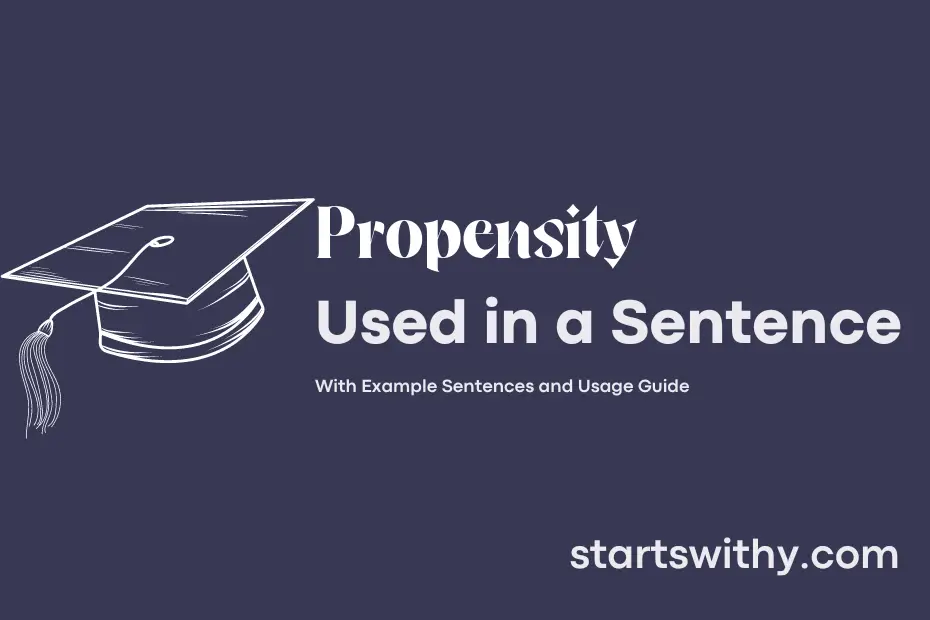Have you ever noticed a tendency or inclination towards a certain behavior or activity? This inclination, known as a “propensity,” refers to a natural inclination or tendency to act in a certain way. People may have propensities towards various actions, whether they be positive or negative behaviors.
Propensities can shape our decisions and actions, influencing the paths we take in life. Understanding our propensities can provide valuable insight into our behavior patterns and help us make more informed choices.
7 Examples Of Propensity Used In a Sentence For Kids
- Appu has a *propensity for eating mangoes every day.*
- Ravi has a *propensity for drawing colorful pictures.*
- Shreya has a *propensity for singing songs loudly.*
- Amar has a *propensity for playing with toy cars.*
- Mira has a *propensity for collecting shiny stones.*
- Raj has a *propensity for jumping and running around.*
- Neha has a *propensity for helping her friends with their homework.*
14 Sentences with Propensity Examples
- Propensity for procrastination is a common struggle among college students.
- She has a propensity for staying up late studying for exams.
- His propensity for skipping classes is affecting his academic performance.
- The group of friends had a propensity for spending all their money on fast food.
- Despite her propensity for partying, she manages to maintain good grades.
- The professor noticed a propensity for plagiarism among some students in the class.
- His propensity for social media distractions hinders his focus during lectures.
- She developed a propensity for stress-eating during exam season.
- The college encourages students to seek help if they have a propensity for substance abuse.
- The club welcomes members with a propensity for community service and volunteer work.
- The student’s propensity for leadership qualities makes them a natural choice for student council positions.
- The campus counselor helps students manage their propensity for anxiety and depression.
- The library offers workshops to help students overcome their propensity for poor time management.
- The university provides resources for students with a propensity for struggling academically.
How To Use Propensity in Sentences?
To use the word “Propensity” in a sentence, begin by understanding its meaning. Propensity refers to a natural tendency or inclination to behave in a certain way or to have a particular interest in something.
Here is an example sentence using Propensity: “She has a propensity for taking risks and trying new things.” In this sentence, the word “propensity” is used to highlight someone’s natural inclination towards adventurous behavior.
When incorporating Propensity into a sentence, consider the context and make sure it fits naturally. You can use it to describe someone’s habits, preferences, tendencies, or behaviors based on their natural inclinations.
To add more detail and depth to your sentence, you can provide examples or explanations that support the propensity mentioned. This helps to create a clearer picture for the reader and enhances the impact of the word usage.
Remember to pay attention to the tone and formality of your writing when using Propensity in a sentence. It is a versatile word that can be applied in various contexts, so feel free to experiment and practice incorporating it into your everyday vocabulary.
Conclusion
In conclusion, the collection of sentences with the keyword “propensity” demonstrated a consistent theme of inclination or tendency towards certain behaviors or characteristics. These examples highlighted individuals’ innate likelihood or natural bent towards specific actions or emotions, showcasing how the term can be applied across various contexts.
By exploring the nuanced meanings of “propensity” through different sentence structures, it becomes evident that this word encapsulates the idea of an inherent tendency or predisposition. Whether referring to someone’s propensity for kindness, risk-taking, or procrastination, these sentences illustrated how this term can effectively convey deeper insights into human behavior and motivations.



